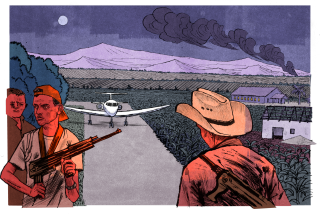In Mexico, a dividing line on ‘El Infierno’
It doesn’t take long for Benjamin Garcia — “El Benny” — to get sucked into hell.
In director Luis Estrada’s new film “El Infierno” (Hell), Garcia is deported to Mexico after living and working illegally in the U.S. for 20 years. He returns to find his hometown (and, by extension, his country) in pitiful shape. Poorer and more violent than ever, the town is populated by crudely vicious drug-trafficking hitmen and the women who serve as their whores. Every authority figure, including the police chief and the parish priest, is on the take. The mayor is a drug lord locked in a nasty cartel war against his own brother.
Garcia resists, at first. But a need for money sends him into the ranks of the local gangsters. He faints at one of his first assignments, as his boss uses a chain saw to cut off the hands of a rival after first slitting off his upper lip.
But soon Benny has traded his jeans and baseball cap for a gaudy white suit, cowboy hat and silver-plated pistol tucked in his shiny belt, and he is greedily enjoying the large wads of cash that flow his way.
Estrada’s controversial film is lurid, provocative — and very funny. It provides an extremely bleak picture of Mexico’s raging drug war and how the drug business corrodes every aspect of Mexican life. It has become a blockbuster in Mexico, delighting critics and thoroughly angering the government.
“No one can see this picture as just entertainment,” Estrada said in an interview, sprinkling his Spanish with English words, much as El Benny does. “There is no redeemable person in the film. There is no hero, no vision of hope. All the characters are bad or worse.”
Not even sainted motherhood is spared. El Benny’s mother scolds him for joining the bad guys. Then she demands his new gold watch.
Estrada’s message is that corruption and impunity, fueled by economic crisis and moral bankruptcy, are rotting Mexico to its core.
“This phenomenon that we are living … chaos, extortion, kidnapping … you change your daily life out of fear,” Estrada said. “The most serious thing now is how all of society is being affected.... Mexicans have become the victims and the executioners, all at the same time.”
Estrada is a prematurely gray 48-year-old who speaks excitedly. “El Infierno” is the third installment in his trilogy on Mexico. The first piece, “La Ley de Herodes” (Herod’s Law) in 1999, won international acclaim and, in the view of many, helped bring down the authoritarian government that ruled Mexico for seven decades and that he parodied in the film. Now, Estrada says, things in Mexico have gotten only worse. Far from resolving the problems of poverty, political evil and social deterioration, the system in Mexico is more corroded, the dire situation exacerbated by an overlay of out-of-control narco-violence.
In a delicious piece of irony, Estrada received funding for the movie from a government commission set up to celebrate Mexico’s bicentennial, the 200th anniversary of the start of the country’s fight for independence from Spain. The film was released right around the celebration date, Sept. 15 and 16, infuriating officials who saw it as overly negative.
None other than President Felipe Calderon weighed in, saying that — though he had not actually seen it — he thought the movie was harmful. “I would just ask that we be a bit more careful with Mexico’s name and image and we avoid demolishing national spirit,” Calderon said.
Ads for “El Infierno” show a sign with the bicentennial logo, Mexico 2010, adorned by a hand-scrawled addendum: “Nothing to celebrate.”
Estrada takes his cinematic cues from the Coen brothers, Kurosawa and Martin Scorsese, with over-the-top violence and no small measure of gallows humor. And he researched the phenomenon of organized crime across the globe and through the generations, from 1930s Chicago to Italy’s Mafias, but, at the end of the day, didn’t have to go much further than local headlines for his material.
One scene shows a human leg protruding from a vat where El Benny’s fellow thugs are disposing of their victims. Mexican viewers immediately assumed this was an allusion to the real-life El Pozolero (The Stewmaker), a cartel henchman arrested early this year and believed responsible for melting several hundred people in a vat of lye. (Actually, says Estrada, he filmed the scene before El Pozolero gained fame and based it on a moment from “Fargo” when a character meets his fate in a woodchipper.)
Audiences laugh, perhaps uncomfortably, as the blood splatters and the bodies mount. Estrada says the laughter is partly a psychological release that also hearkens to Mexico’s cultural fascination with death as seen in the common use of skeletons in folklore and native art.
“In this movie we watch scenes as though we were watching the evening news; everything is familiar, even the most absurd moments,” observed Guadalupe Loaeza, a well-known social critic. “Going to this movie is cheaper than seeing a psychiatrist.”
The government gave “El Infierno” its strictest rating, pronouncing it forbidden for minors (even though there is only one sex scene, also played for laughs, and the violence probably isn’t worse than in many an American slasher flick).
The rating doesn’t seem to be deterring crowds who especially filled theaters over the recent national holidays.
“I’m glad this movie was made so that the government realizes we are not idiots and we don’t buy the line that they are winning the war with the narcos,” Carla Lopez Santillan, a 31-year-old lawyer, said as she emerged from the cinema in the wealthy Santa Fe suburb.
“It’s Mexico!” said Francisco Torres, an accountant. “The police are corrupt, the government is corrupt, the Church is in on it....”
Estrada, who does not yet have a U.S. distributor for the film, says an important sub-theme to “El Infierno” is the ease with which Mexican youth, bereft of better opportunities, step in league with drug traffickers.
“We cannot close our eyes to the reality that there is temptation for young people,” Estrada said. “Young people who cannot find opportunities of employment or of studying. Even aware of the risks, they find themselves attracted to this dark side.”
In the movie, El Benny (played by veteran Mexican actor Damian Alcazar) hopes to protect his nephew from such a fate. He fails.
“I’m trying to invite Mexicans to a collective reflection,” Estrada said. “I don’t know how many people get that. But you do get the impression that the movie moves something in people, that it makes them think, it makes them reassess the state of things.... It’s a mirror in which you don’t like the image you see. But it does provoke a catharsis.”
wilkinson@latimes.com
Cecilia Sanchez of The Times’ Mexico City bureau contributed to this report.
More to Read
The biggest entertainment stories
Get our big stories about Hollywood, film, television, music, arts, culture and more right in your inbox as soon as they publish.
You may occasionally receive promotional content from the Los Angeles Times.







